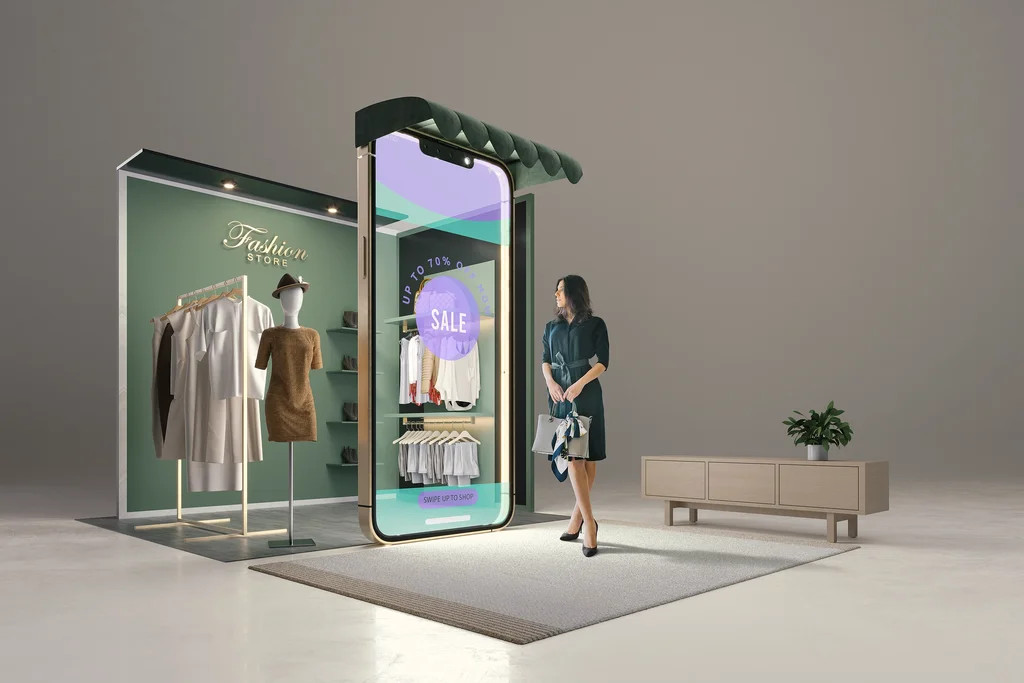A virtual store is an e-commerce platform enhanced by Extended Reality (XR) technologies, including Virtual Reality (VR), Augmented Reality (AR), and holographic displays. These stores offer immersive shopping experiences, allowing customers to interact with products in a virtual environment. Through the use of 3D models and AR/VR integration, virtual stores offer more than traditional websites, creating an engaging, interactive experience that closely resembles being inside a physical store.
In a virtual store, customers can explore products in detail, try them on virtually, or see how they fit in their surroundings, making the shopping experience more personalized and reducing the likelihood of returns. While similar to conventional e-commerce websites, virtual stores stand out by offering heightened visibility and involvement through XR technologies.
How Does a Virtual Store Work?
Virtual stores combine the features of traditional retail with the convenience of online shopping. In a virtual environment, customers can interact with products, view them from all angles, and gain detailed information. They also benefit from online shopping features like 24/7 access, personalized recommendations, quick processing, and multiple payment options.
One key advantage of virtual stores is the ability to virtually try on or interact with products before purchase. For example, the Nike Fit app uses AR technology to help users determine the correct shoe size by simply pointing their smartphone at their feet. Similarly, Pinterest allows users to virtually place over 80,000 furniture items in their living spaces before making a decision.
Although virtual stores can’t completely replicate the tactile experience of physical shopping, they offer unique opportunities such as visualizing furniture in a room before purchase or browsing an entire product line in 3D. This flexibility makes virtual stores an attractive alternative for both customers and businesses.
Types of Virtual Stores
There are various types of virtual stores, each offering different levels of interaction:
- Virtual Try-On: Allows customers to try on clothing or accessories virtually using AR or VR.
- Virtual Try-Out: Customers can check how products, such as furniture, fit into their surroundings using AR.
- Virtual Reality Store: Customers use VR headsets to enter a fully virtual store environment, where they can explore and interact with products.
- Visual Search: AI-powered systems allow users to find products even if they don’t know their names, such as locating an outfit seen on the street.
- 360-Degree View: Products are displayed as 3D models that users can explore from all angles.
- 3D Stores: These websites allow customers to navigate a 3D virtual space resembling a physical store and interact with the displayed items.
The Benefits of a Virtual Store
1. Boost Sales
Virtual stores help customers make more informed decisions by allowing them to interact with products in a more meaningful way. Studies suggest that 70% of visitors to virtual stores end up making a purchase, thanks to the immersive and engaging shopping experience.
2. Create an Immersive and Personalized Shopping Experience
Virtual stores mimic the feel of physical shops, allowing customers to explore items, try them on, and visualize products in various colors and styles. This personalized interaction not only aids decision-making but also boosts user satisfaction and engagement.
3. Increase Customer Retention
The interactive and entertaining nature of virtual stores keeps customers engaged, increasing retention rates. Positive shopping experiences also lead to repeat purchases, with 54% of people stating that a good experience determines their return to a store.
4. Enhance Customer Loyalty and Brand Awareness
Innovative shopping technologies help build a brand’s reputation as forward-thinking and customer-centric. Memorable experiences and personalized interactions encourage customers to recommend the brand to others, enhancing loyalty and increasing word-of-mouth marketing.
5. Collect Customer Data and Perform Analytics
Virtual stores provide valuable customer insights by tracking user behavior, preferences, and engagement. This data helps brands improve their marketing strategies, personalize shopping experiences, and conduct experiments, like product placement tests, to optimize sales.
The Disadvantages of a Virtual Store
While virtual stores offer numerous benefits, there are also some challenges:
- High Cost of Development: Creating a virtual store can be expensive, requiring 3D models, 360-degree photography, and specialized software.
- Need for Special Equipment: VR stores require customers to have VR headsets, which limits accessibility. AR stores, however, only need a smartphone with an app.
- High-Speed Internet Requirement: A fast internet connection is necessary to handle the data load of a virtual store, especially for rendering 3D models and interactive elements.
Virtual Stores Examples
Several notable brands have already adopted virtual stores:
- Ralph Lauren: Recreated its physical showrooms in a virtual environment using AR technology, offering a fully immersive shopping experience.
- Charlotte Tilbury: Offers a gamified virtual store where customers can shop for cosmetics, watch tutorials, and even enjoy group shopping with friends.
- Dior: Created the “Atelier of Dreams,” an exclusive virtual boutique with themed experiences, helping attract new visitors and increasing engagement.
- Dyson: Launched a VR store where customers can explore product functionality in detail and even watch interviews with engineers.
The Future of Virtual Stores
The future looks promising for virtual stores as e-commerce continues to evolve. With projections that the retail e-commerce market will hit $7.4 billion in sales by 2025, businesses will need to adopt innovative solutions like virtual stores to stand out and attract customers. As the metaverse develops, virtual stores will likely become an integral part of the retail landscape, offering immersive experiences alongside social media and mobile platforms.
In summary, while virtual stores can’t completely replace physical retail, they offer a powerful alternative to conventional e-commerce, providing businesses and customers with numerous opportunities for enhanced engagement and interaction.
